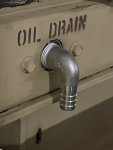Hi Everyone, I purchased a new to me trailer mounted 802A and I have concerns about crankcase pressure.
A little background on the unit. The genset is 1999 with a remanufactured engine and the trailer has a date of 10/12 painted on it so I am thinking it went through a reset in 2012 and hasn’t seen much use since then based on condition of the block, etc. There are partial remnants of a small tag and wire tie under the emergency stop button but no longer legible. This could be a break-in tag or who knows.
The unit runs good at idle with no load, has 60 psi oil pressure when cold (40f), and doesn’t smoke. I have not replaced the oil just yet, which looks lightly used but it does seem thin in weight to me, which has me thinking it could be break-in oil? I didn’t want to put expensive oil in it until I felt the unit was in good condition and I guess staying away from synthetic is good if the issue is that it’s not broken in.
I noticed some air/steam blow-by with the dipstick and/or oil fill cap removed (no load). I purchased a digital manometer and I measured up to a scary 2.5“ H2O at no load idle. The gauge jumped around from -.15 to 1.5 and worse 2.5.
I did notice that the air filter seemed at least a little dirty so I will replace that first but is there anything that can help if that is not the issue?
If the engine does have break-in oil, is that amount of blow-by common until rings seat? I do have some John Deere break-in oil if the issue is that rings have not seated.
If the rings are sticking should I run some seafoam or other cleaner in the oil and fuel prior to an oil change and putting new break-in or 15w/40 in it? If yes, how long should I run the engine and with or without load?
Appreciate the feedback. I really hope I don’t have a unit that needs rebuilt because it’s more than I want to get into. Unsure how to approach this situation since I don’t know the history of the unit and last thing I want to do is make things worse.
A little background on the unit. The genset is 1999 with a remanufactured engine and the trailer has a date of 10/12 painted on it so I am thinking it went through a reset in 2012 and hasn’t seen much use since then based on condition of the block, etc. There are partial remnants of a small tag and wire tie under the emergency stop button but no longer legible. This could be a break-in tag or who knows.
The unit runs good at idle with no load, has 60 psi oil pressure when cold (40f), and doesn’t smoke. I have not replaced the oil just yet, which looks lightly used but it does seem thin in weight to me, which has me thinking it could be break-in oil? I didn’t want to put expensive oil in it until I felt the unit was in good condition and I guess staying away from synthetic is good if the issue is that it’s not broken in.
I noticed some air/steam blow-by with the dipstick and/or oil fill cap removed (no load). I purchased a digital manometer and I measured up to a scary 2.5“ H2O at no load idle. The gauge jumped around from -.15 to 1.5 and worse 2.5.
I did notice that the air filter seemed at least a little dirty so I will replace that first but is there anything that can help if that is not the issue?
If the engine does have break-in oil, is that amount of blow-by common until rings seat? I do have some John Deere break-in oil if the issue is that rings have not seated.
If the rings are sticking should I run some seafoam or other cleaner in the oil and fuel prior to an oil change and putting new break-in or 15w/40 in it? If yes, how long should I run the engine and with or without load?
Appreciate the feedback. I really hope I don’t have a unit that needs rebuilt because it’s more than I want to get into. Unsure how to approach this situation since I don’t know the history of the unit and last thing I want to do is make things worse.
Attachments
-
103 KB Views: 25
-
102 KB Views: 25
Last edited:










